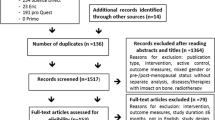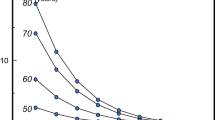Abstract
Summary
Within a normative youth cohort (16–29 years) bone parameters for males and females remained stable at the radius. At the tibia, a peak was observed for females at 16–19 years, with bone density and strength decreasing by 29 years.
Purpose
To determine if bone microstructural and strength parameters identified by high-resolution peripheral quantitative computed tomography (HR-pQCT) and finite element analysis (FEA) at the distal radius and tibia, peak within the age range of this youth cohort, and whether the timing of the peaks differ based on sex or skeletal site.
Methods
We recruited 251 participants (158 female; 16 to 29 years), grouping them into 5-year age brackets (16–19; 20–24; 25–29 years) assessing microstructural and strength parameters with HR-pQCT and FEA.
Results
HR-pQCT assessment of males and females (age-matched groups) showed males had higher total area and BMD, trabecular BMD and trabecular number (radius only) cortical thickness and porosity, and failure load, but lower cortical BMD (p < 0.05). Within sex, microstructural and strength parameters remained stable for males, but in females they appeared to peak at 16–19 years at the tibia. Tibia bone strength and trabecular BMD were highest in females 16–19 years (p < 0.05), and tibia cortical porosity was lowest in females 16–19 years (p < 0.001). With the exception of an age-related increase in cortical BMD, all other parameters were stable between 16 and 29 years at the radius for both males and females. We found no peak values for males or females at the radius. At the tibia, a peak was observed for females 16–19 years.
Conclusion
These data provide a population-based assessment of bone microstructural and strength parameters from HR-pQCT and FEA in a youth cohort, showing clear differences in bone quality dependent on sex and skeletal site.

Similar content being viewed by others
References
Baxter-Jones AD, Faulkner RA, Forwood MR, Mirwald RL, Bailey DA (2011) Bone mineral accrual from 8 to 30 years of age: an estimation of peak bone mass. J Bone Miner Res 26(8):1729–1739
Faulkner R, Bailey D (2007) Osteoporosis: a pediatric concern? Med Sports Sci 51:1–12
Boot AM, de Ridder MA, van der Sluis IM, van Slobbe I, Krenning EP, de Muinck Keizer-Schrama SM (2010) Peak bone mineral density, lean body mass and fractures. Bone 46(2):336–341
Lorentzon M, Mellström D, Ohlsson C (2005) Age of attainment of peak bone mass is site specific in Swedish men—the GOOD study. J Bone Miner Res 20(7):1223–1227
Lu PW, Briody JN, Ogle GD, Morley K, Humphries IR, Allen J, Howman-Giles R, Sillence D, Cowell CT (1994) Bone mineral density of total body, spine, and femoral neck in children and young adults: a cross-sectional and longitudinal study. J Bone Miner Res 9(9):1451–1458
Matkovic V, Jelic T, Wardlaw GM, Ilich JZ, Goel PK, Wright JK, Andon MB, Smith KT, Heaney RP (1994) Timing of peak bone mass in Caucasian females and its implication for the prevention of osteoporosis. Inference from a cross-sectional model. J Clin Invest 93(2):799–808
Wren TA, Kim PS, Janicka A, Sanchez M, Gilsanz V (2007) Timing of peak bone mass: discrepancies between CT and DXA. J Clin Endocrinol Metab 92(3):938–941
Berger C, Goltzman D, Langsetmo L, Joseph L, Jackson S, Kreiger N, Tenenhouse A, Davison KS, Josse RG, Prior JC (2010) Peak bone mass from longitudinal data: implications for the prevalence, pathophysiology, and diagnosis of osteoporosis. J Bone Miner Res 25(9):1948–1957
Lin Y-C, Lyle R, Weaver C, McCabe L, McCabe G, Johnston C, Teegarden D (2003) Peak spine and femoral neck bone mass in young women. Bone 32(5):546–553
Hernandez CJ, Beaupre GS, Carter DR (2003) A theoretical analysis of the relative influences of peak BMD, age-related bone loss and menopause on the development of osteoporosis. Osteoporos Int 14(10):843–847
Schonau E (2004) The peak bone mass concept: is it still relevant? Pediatr Nephrol 19(8):825–831
Vilayphiou N, Boutroy S, Sornay-Rendu E, Munoz F, Delmas PD, Chapurlat R (2010) Finite element analysis performed on radius and tibia HR-pQCT images and fragility fractures at all sites in postmenopausal women. Bone 46(4):1030–1037
Vilayphiou N, Boutroy S, Szulc P, van Rietbergen B, Munoz F, Delmas PD, Chapurlat R (2011) Finite element analysis performed on radius and tibia HR-pQCT images and fragility fractures at all sites in men. J Bone Miner Res 26(5):965–973
Nishiyama K, Macdonald H, Hanley D, Boyd S (2012) Women with previous fragility fractures can be classified based on bone microarchitecture and finite element analysis measured with HR-pQCT. Osteoporosis Int 24(5):1733–1740
Burrows M, Liu D, McKay H (2010) High-resolution peripheral QCT imaging of bone micro-structure in adolescents. Osteoporosis Int 21(3):515–520
Burrows M, Liu D, Moore S, McKay H (2010) Bone microstructure at the distal tibia provides a strength advantage to males in late puberty: an HR-pQCT study. J Bone Miner Res 25(6):1423–1432
Kirmani S, Christen D, van Lenthe GH, Fischer PR, Bouxsein ML, McCready LK, Melton LJ, Riggs BL, Amin S, Müller R (2009) Bone structure at the distal radius during adolescent growth. J Bone Miner Res 24(6):1033–1042
Nishiyama KK, Macdonald HM, Moore SA, Fung T, Boyd SK, McKay HA (2012) Cortical porosity is higher in boys compared with girls at the distal radius and distal tibia during pubertal growth: an HR-pQCT study. J Bone Miner Res 27(2):273–282
Wang Q, Wang XF, Iuliano-Burns S, Ghasem-Zadeh A, Zebaze R, Seeman E (2010) Rapid growth produces transient cortical weakness: a risk factor for metaphyseal fractures during puberty. J Bone Miner Res 25(7):1521–1526
Dalzell N, Kaptoge S, Morris N, Berthier A, Koller B, Braak L, van Rietbergen B, Reeve J (2009) Bone micro-architecture and determinants of strength in the radius and tibia: age-related changes in a population-based study of normal adults measured with high-resolution pQCT. Osteoporosis Int 20(10):1683–1694
Khosla S, Riggs BL, Atkinson EJ, Oberg AL, McDaniel LJ, Holets M, Peterson JM, Melton LJ (2006) Effects of sex and age on bone microstructure at the ultradistal radius: a population-based noninvasive in vivo assessment. J Bone Miner Res 21(1):124–131
Macdonald HM, Nishiyama KK, Kang J, Hanley DA, Boyd SK (2011) Age–related patterns of trabecular and cortical bone loss differ between sexes and skeletal sites: a population-based HR-pQCT study. J Bone Miner Res 26(1):50–62
Zhou W, Langsetmo L, Berger C, Adachi JD, Papaioannou A, Ioannidis G, Webber C, Atkinson SA, Olszynski WP, Brown JP (2010) Normative bone mineral density z-scores for Canadians aged 16 to 24 years: the Canadian Multicenter Osteoporosis Study. J Clin Densitom 13(3):267–276
Kreiger N, Tenenhouse A, Joseph L, Mackenzie T, Poliquin S, Brown JP, Prior JC, Rittmaster RS (1999) Research notes: the Canadian multicentre osteoporosis study (CaMos): background, rationale, methods. Can J Aging 18(03):376–387
Tenenhouse A, Kreiger N, Hanley D (2000) Canadian multicentre osteoporosis study (CaMos). Drug Dev Res 49(3):201–205
Boutroy S, Bouxsein ML, Munoz F, Delmas PD (2005) In vivo assessment of trabecular bone microarchitecture by high-resolution peripheral quantitative computed tomography. J Clin Endocrinol Metab 90(12):6508–6515
Pauchard Y, Liphardt AM, Macdonald HM, Hanley DA, Boyd SK (2012) Quality control for bone quality parameters affected by subject motion in high-resolution peripheral quantitative computed tomography. Bone 50(6):1304–1310
Buie HR, Campbell GM, Klinck RJ, MacNeil JA, Boyd SK (2007) Automatic segmentation of cortical and trabecular compartments based on a dual threshold technique for in vivo micro-CT bone analysis. Bone 41(4):505–515
Burghardt AJ, Buie HR, Laib A, Majumdar S, Boyd SK (2010) Reproducibility of direct quantitative measures of cortical bone microarchitecture of the distal radius and tibia by HR-pQCT. Bone 47(3):519–528
Nishiyama KK, Macdonald HM, Buie HR, Hanley DA, Boyd SK (2010) Postmenopausal women with osteopenia have higher cortical porosity and thinner cortices at the distal radius and tibia than women with normal aBMD: an in vivo HR-pQCT study. J Bone Miner Res 25(4):882–890
Burghardt AJ, Kazakia GJ, Ramachandran S, Link TM, Majumdar S (2010) Age-and gender-related differences in the geometric properties and biomechanical significance of intracortical porosity in the distal radius and tibia. J Bone Miner Res 25(5):983–993
MacNeil JA, Boyd SK (2008) Bone strength at the distal radius can be estimated from high-resolution peripheral quantitative computed tomography and the finite element method. Bone 42(6):1203–1213
Pistoia W, Van Rietbergen B, Lochmüller E-M, Lill C, Eckstein F, Rüegsegger P (2002) Estimation of distal radius failure load with micro-finite element analysis models based on three-dimensional peripheral quantitative computed tomography images. Bone 30(6):842–848
Looker AC, Wahner HW, Dunn WL, Calvo MS, Harris TB, Heyse SP, Johnston CC Jr, Lindsay R (1998) Updated data on proximal femur bone mineral levels of US adults. Osteoporos Int 8(5):468–489
Looker AC, Melton L III, Borrud L, Shepherd J (2012) Lumbar spine bone mineral density in US adults: demographic patterns and relationship with femur neck skeletal status. Osteoporos Int 23(4):1351–1360
Watts NB, Leslie WD, Foldes AJ, Miller PD (2013) 2013 International Society for Clinical Densitometry Position Development Conference: task force on normative databases. J Clin Densitom 16(4):472–481
Burghardt AJ, Kazakia GJ, Ramachandran S, Link TM, Majumdar S (2010) Age- and gender-related differences in the geometric properties and biomechanical significance of intracortical porosity in the distal radius and tibia. J Bone Miner Res 25(5):983–993
Duren DL, Seselj M, Froehle AW, Nahhas RW, Sherwood RJ (2013) Skeletal growth and the changing genetic landscape during childhood and adulthood. Am J Phys Anthropol 150(1):48–57
Gordon CL, Halton JM, Atkinson SA, Webber CE (1991) The contributions of growth and puberty to peak bone mass. Growth Dev Aging 55(4):257–262
Tanner JM, Whitehouse RH, Hughes PC, Carter BS (1976) Relative importance of growth hormone and sex steroids for the growth at puberty of trunk length, limb length, and muscle width in growth hormone-deficient children. J Pediatr 89(6):1000–1008
Garn SM (1970) The earlier gain and the later loss of cortical bone, in nutritional perspective. Thomas, Springfield
Schoenau E, Neu C, Rauch F, Manz F (2002) Gender-specific pubertal changes in volumetric cortical bone mineral density at the proximal radius. Bone 31(1):110–113
Schoenau E, Neu C, Mokov E, Wassmer G, Manz F (2000) Influence of puberty on muscle area and cortical bone area of the forearm in boys and girls. J Clin Endocrinol Metab 85(3):1095–1098
Seeman E (2001) Sexual dimorphism in skeletal size, density, and strength. J Clin Endocrinol Metab 86(10):4576–4584
Turner CH, Burr DB (1993) Basic biomechanical measurements of bone: a tutorial. Bone 14(4):595–608
Augat P, Schorlemmer S (2006) The role of cortical bone and its microstructure in bone strength. Age and ageing 35(2):ii27–ii31
Wachter NJ, Augat P, Krischak GD, Mentzel M, Kinzl L, Claes L (2001) Prediction of cortical bone porosity In Vitro by microcomputed tomography. Calcif Tissue Int 68(1):38–42
Acknowledgments
The authors would like to thank all the participants who graciously devoted time to participate in the study, Michelle Kan for scan acquisition, and Jane Allan and Bernice Love for their assistance in participant recruitment and administering the extensive interview-based questionnaire.
This study was funded by the Canadian Institutes of Health Research (CIHR) MOP-106611.
Conflicts of interest
Lauren A Burt, Heather M Macdonald, David A Hanley and Steven K Boyd declare that they have no conflict of interest.
Author information
Authors and Affiliations
Corresponding author
Rights and permissions
About this article
Cite this article
Burt, L.A., Macdonald, H.M., Hanley, D.A. et al. Bone microarchitecture and strength of the radius and tibia in a reference population of young adults: an HR-pQCT study. Arch Osteoporos 9, 183 (2014). https://doi.org/10.1007/s11657-014-0183-2
Received:
Accepted:
Published:
DOI: https://doi.org/10.1007/s11657-014-0183-2




